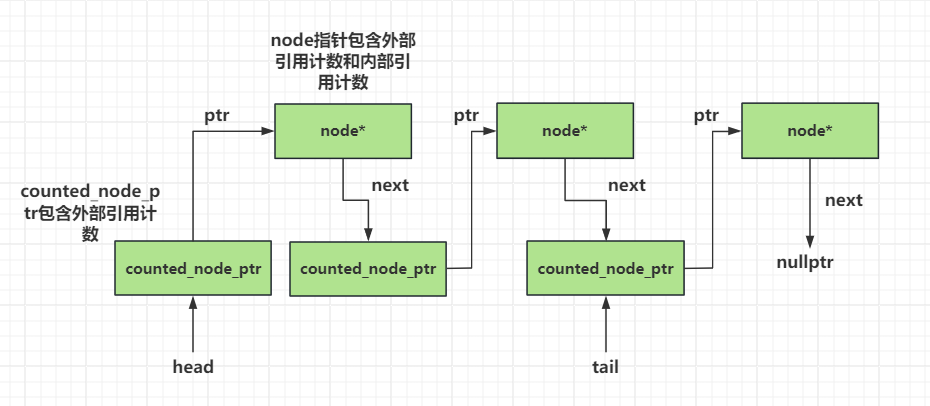简介
前文介绍了无锁并发栈的设计,本文继续介绍无锁队列的设计。队列和栈容器的难点稍微不同,因为对于队列结构,push()和pop()分别访问其不同部分,而在栈容器上,这两项操作都访问头节点,所以两种数据结构所需的同步操作相异。如果某线程在队列一端做出改动,而另一线程同时访问队列另一端,代码就要保证前者的改动过程能正确地为后者所见
单一消费者和生产者队列
我们实现一个简单的无锁队列,只应对一个生产者一个消费者的情况,便于我们理解
#include<atomic>#include<memory>template<typename T>class SinglePopPush{private:struct node{std::shared_ptr<T> data;node* next;node() :next(nullptr){}};std::atomic<node*> head;std::atomic<node*> tail;node* pop_head(){node* const old_head = head.load();// ⇽-- - 1if (old_head == tail.load()){return nullptr;}head.store(old_head->next);return old_head;}public:SinglePopPush() :head(new node), tail(head.load()){}SinglePopPush(const SinglePopPush& other) = delete;SinglePopPush& operator=(const SinglePopPush& other) = delete;~SinglePopPush(){while (node* const old_head = head.load()){head.store(old_head->next);delete old_head;}}std::shared_ptr<T> pop(){node* old_head = pop_head();if (!old_head){return std::shared_ptr<T>();}// ⇽-- -2std::shared_ptr<T> const res(old_head->data);delete old_head;return res;}void push(T new_value){std::shared_ptr<T> new_data(std::make_shared<T>(new_value));// ⇽-- - 3node* p = new node;//⇽-- - 4node* const old_tail = tail.load();//⇽-- - 5old_tail->data.swap(new_data);//⇽-- - 6old_tail->next = p;//⇽-- - 7tail.store(p);}};
上面的实现初看上去还不错。在同一时刻,如果只有一个线程调用push(),且仅有一个线程调用pop(),这份代码便可以相对完美地工作。
本例中的push()和pop()之间存在先行关系,这点很重要,它使队列的使用者可安全地获取数据。
tail指针的存储操作7与其载入操作1同步:按控制流程,在运行push()的线程上,原有的尾节点中的data指针先完成存储操作5,然后tail才作为指针存入新值7;
并且,在运行pop()的线程上,tail指针先完成载入操作1,原来的data指针才执行加载操作2,故data的存储操作5在载入操作1之前发生
(全部环节正确无误。因此这个单一生产者、单一消费者(Single-Producer Single-Consumer,SPSC)队列可以完美地工作。
不过,若多个线程并发调用push()或并发调用pop(),便会出问题。我们先来分析push()。如果有两个线程同时调用push(),就会分别构造一个新的空节点并分配内存3,而且都从tail指针读取相同的值4,结果它们都针对同一个尾节点更新其数据成员,却各自把data指针和next指针设置为不同的值5和6。这形成了数据竞争!
pop_head()也有类似问题,若两个线程同时调用这个函数,它们就会读取同一个头节点而获得相同的next指针,而且都把它赋予head指针以覆盖head指针原有的值。最终两个线程均认为自己获取了正确的头节点,这是错误的根源。给定一项数据,我们不仅要确保仅有一个线程可对它调用pop(),如果有别的线程同时读取头节点,则还需保证它们可以安全地访问头节点中的next指针。我们曾在前文的无锁栈容器中遇见过类似问题,其pop()函数也有完全相同的问题。
多线程push
解决多线程push的竞争问题。
一种方法是将data指针原子化,通过比较-交换操作来设置它的值。如果比较-交换操作成功,所操作的节点即为真正的尾节点,我们便可安全地设定next指针,使之指向新节点。若比较-交换操作失败,就表明有另一线程同时存入了数据,我们应该进行循环,重新读取tail指针并从头开始操作。
如果std::shared_ptr<>上的原子操作是无锁实现,那便万事大吉,否则我们仍需采取别的方法。一种可行的方法是令pop()返回std::unique_ptr<>指针(凭此使之成为指涉目标对象的唯一指针),并在队列中存储指向数据的普通指针。这样让代码得以按std::atomic<T*>的形式存储指针,支持必要的compare_exchange_strong()调用。
void push(T new_value){std::unique_ptr<T> new_data(new T(new_value));counted_node_ptr new_next;new_next.ptr=new node;new_next.external_count=1;for(;;){//⇽--- 1node* const old_tail=tail.load();T* old_data=nullptr;//⇽--- 2if(old_tail->data.compare_exchange_strong(old_data,new_data.get())){old_tail->next=new_next;// 3tail.store(new_next.ptr);new_data.release();break;}}}
引用计数避免了上述的数据竞争,但那不是push()中仅有的数据竞争。只要我们仔细观察,便会发现其代码模式与栈容器相同:先载入原子指针1,然后依据该指针读取目标值2。
另一线程有可能同时更新tail指针3,如果该更新在pop()内部发生,最终将导致删除尾节点。若尾节点先被删除,代码却依然根据指针读取目标值,就会产生未定义行为。
有一种方法能解决上面的问题,且该方法颇具吸引力:在尾节点中添加一外部计数器,与处理头节点的方法相同。不过队列中的每个节点已配备一个外部计数器,分别存储在对应前驱节点内的next指针中。
若要让同一个节点具有两个外部计数器,便需要改动引用计数的实现方式,以免过早删除节点。我们为了满足上述要求,可在节点的结构体中记录外部计数器的数目,外部计数器一旦发生销毁,该数目则自减,并且将该外部计数器的值加到内部计数器的值之上。对于任意特定节点,如果内部计数器的值变为零,且再也没有外部计数器存在,我们就知道该节点能被安全地删除.
template<typename T>class lock_free_queue{private:struct node;struct counted_node_ptr{int external_count;node* ptr;};std::atomic<counted_node_ptr> head;//⇽--- 1std::atomic<counted_node_ptr> tail;struct node_counter{unsigned internal_count:30;//⇽--- 2unsigned external_counters:2;};struct node{std::atomic<T*> data;//⇽--- 3std::atomic<node_counter> count;counted_node_ptr next;node(){node_counter new_count;new_count.internal_count=0;//⇽--- 4new_count.external_counters=2;count.store(new_count);next.ptr=nullptr;next.external_count=0;}};public:void push(T new_value){std::unique_ptr<T> new_data(new T(new_value));counted_node_ptr new_next;new_next.ptr=new node;new_next.external_count=1;counted_node_ptr old_tail=tail.load();for(;;){// 5increase_external_count(tail,old_tail);T* old_data=nullptr;// 6if(old_tail.ptr->data.compare_exchange_strong(old_data,new_data.get())){old_tail.ptr->next=new_next;old_tail=tail.exchange(new_next);// 7free_external_counter(old_tail);new_data.release();break;}old_tail.ptr->release_ref();}}};
tail指针(1处) 和head指针的型别均为atomic<counted_node_ptr>,而node结构体则以成员count (3处)取代原有的internal_count。
该count成员也是一个结构体,内含internal_count变量和新引入的external_counters变量(2处) 。请注意,external_counters仅需使用两位,因为同一个节点最多只可能有两个外部计数器。因此,结构体count为它分配了一个两位的位域,而把internal_count设定为30位的整型值,从而维持了计数器32位的整体尺寸。
按此处理,内部计数器的取值范围仍然非常大,还保证了在32位或64位计算机上,一个机器字(machine word)便能容纳整个结构体。后文很快会解释,为了杜绝条件竞争,上述两种计数器必须合并,视作单一数据项,共同进行更新。只要把结构体的大小限制在单个机器字内,那么在许多硬件平台上,其原子操作就更加有机会以无锁方式实现。
节点经过初始化,其internal_count成员被置零,而external_counters成员则设置成2(4处),因为我们向队列加入的每个新节点,它最初既被tail指针指涉,也被前一个节点的next指针指涉。
我们先调用一个新函数increase_external_count()令外部计数器的值增加(5处),再载入tail指针,进而读取尾节点的data成员并对它调用compare_exchange_strong()(6处),然后对原有的tail指针执行free_external_counter()(7处)。
我们画一下这个图

多线程pop
多线程pop实现和之前无锁栈类似,我们只要做外部引用计数的增加和内部引用计数的减少即可
template<typename T>class lock_free_queue{private:struct node{void release_ref();//node的余下代码与代码清单7.16相同};public:std::unique_ptr<T> pop(){// 1counted_node_ptr old_head=head.load(std::memory_order_relaxed);for(;;){//2increase_external_count(head,old_head);node* const ptr=old_head.ptr;if(ptr==tail.load().ptr){//3ptr->release_ref();return std::unique_ptr<T>();}// 4if(head.compare_exchange_strong(old_head,ptr->next)){T* const res=ptr->data.exchange(nullptr);// 5free_external_counter(old_head);return std::unique_ptr<T>(res);}// 6ptr->release_ref();}}};
节点的弹出操作从加载old_head指针开始(1处),接着进入一个无限循环,并且令已加载好的指针上的外部计数器的值自增(2处)。若头节点正巧就是尾节点,即表明队列内没有数据,我们便释放引用(3处),并返回空指针。
否则表明队列中存在数据,因此当前线程试图调用compare_exchange_strong()将其收归己有(4处)。以上调用会对比结构体head和old_head,其成员都包括外部计数器和指针,但均被视作一个整体。无论哪个成员发生了变化而导致不匹配,代码即释放引用(6处)并重新循环。
如果比较-交换操作成功,当前线程就顺利地将节点所属的数据收归己有,故我们随即释放弹出节点的外部计数器(5处),再将数据返回给pop()的调用者。若两个外部计数器都被释放,且内部计数器值变为0,则节点本身可被删除。有几个函数负责处理引用计数
下面是减少引用计数的函数
template<typename T>class lock_free_queue{private:struct node{void release_ref(){node_counter old_counter=count.load(std::memory_order_relaxed);node_counter new_counter;do{new_counter=old_counter;//1--new_counter.internal_count;}//2while(!count.compare_exchange_strong(old_counter,new_counter,std::memory_order_acquire,std::memory_order_relaxed));if(!new_counter.internal_count &&!new_counter.external_counters){//3delete this;}}};};
尽管我们在这里只改动位域成员internal_count(1处),也必须按原子化方式更新整个计数器结构体。所以更新操作要用比较-交换函数配合循环实现(2处)。
当计数器internal_count完成自减后,如果内外两个计数器的值均为0,就表明调用release_ref()的是最后一个指涉目标节点的指针(代码清单pop (5 6两处)的ptr),我们应当删除节点(3处)。
接下来我们实现增加引用计数的操作
template<typename T>class lock_free_queue{private:static void increase_external_count(std::atomic<counted_node_ptr>& counter,counted_node_ptr& old_counter){counted_node_ptr new_counter;do{new_counter=old_counter;++new_counter.external_count;}while(!counter.compare_exchange_strong(old_counter,new_counter,std::memory_order_acquire,std::memory_order_relaxed));old_counter.external_count=new_counter.external_count;}};
increase_external_count()已改成了静态成员函数,需要更新的目标不再是自身固有的成员计数器,而是一个外部计数器,它通过第一个参数传入函数以进行更新。
针对无锁队列的节点释放其外部计数器
template<typename T>class lock_free_queue{private:static void free_external_counter(counted_node_ptr &old_node_ptr){node* const ptr=old_node_ptr.ptr;int const count_increase=old_node_ptr.external_count-2;node_counter old_counter=ptr->count.load(std::memory_order_relaxed);node_counter new_counter;do{new_counter=old_counter;//⇽--- 1--new_counter.external_counters;//⇽--- 2new_counter.internal_count+=count_increase;}//⇽--- 3while(!ptr->count.compare_exchange_strong(old_counter,new_counter,std::memory_order_acquire,std::memory_order_relaxed));if(!new_counter.internal_count &&!new_counter.external_counters){//⇽--- 4delete ptr;}}};
与free_external_counter()对应的是increase_external_count()函数,该函数对整个计数器结构体仅执行一次compare_exchange_strong(),便合并更新了其中的两个计数器(3处),这与release_ref()中更新internal_count的自减操作类似。
计数器external_counters则同时自减(1处)。如果这两个值均变为0,就表明目标节点再也没有被指涉,遂可以安全删除(4处)。
为了避免条件竞争,上述更新行为需要整合成单一操作完成,因此需要用比较-交换函数配合循环运行。若两项更新分别独立进行,万一有两个线程同时调用该函数,则它们可能都会认为自己是最后的执行者,所以都删除节点,结果产生未定义行为。
优化
虽然上述代码尚可工作,也无条件竞争,但依然存在性能问题。一旦某线程开始执行 push()操作,针对 old_tail.ptr->data成功完成了compare_exchange_strong()调用(push代码6处),就没有其他线程可以同时运行push()。若有其他任何线程试图同时压入数据,便始终看不到nullptr,而仅能看到上述线程执行push()传入的新值,导致compare_exchange_strong()调用失败,最后只能重新循环。这实际上是忙等,消耗CPU周期却一事无成,结果形成了实质的锁。第一个push()调用令其他线程发生阻塞,直到执行完毕才解除,所以这段代码不是无锁实现。问题不止这一个。若别的线程被阻塞,则操作系统会提高对互斥持锁的线程的优先级,好让它尽快完成,但本例却无法依此处理,被阻塞的线程将一直消耗CPU周期,等到最初调用push()的线程执行完毕才停止。这个问题带出了下一条妙计:让等待的线程协助正在执行push()的线程,以实现无锁队列。
我们很清楚应该在这种方法中具体做什么:先设定尾节点上的next指针,使之指向一个新的空节点,且必须随即更新tail指针。由于空节点全都等价,因此这里所用空节点的起源并不重要,其创建者既可以是成功压入数据的线程,也可以是等待压入数据的线程。如果将节点内的next指针原子化,代码就能借compare_exchange_strong()设置其值。只要设置好了next指针,便可使用compare_exchange_weak()配合循环设定tail指针,借此令它依然指向原来的尾节点。若tail指针有变,则说明它已同时被别的线程更新过,因此我们停止循环,不再重试。
pop()需要稍微改动才可以载入原子化的next指针
template<typename T>class lock_free_queue{private:struct node{std::atomic<T*> data;std::atomic<node_counter> count;//⇽--- 1std::atomic<counted_node_ptr> next;};public:std::unique_ptr<T> pop(){counted_node_ptr old_head=head.load(std::memory_order_relaxed);for(;;){increase_external_count(head,old_head);node* const ptr=old_head.ptr;if(ptr==tail.load().ptr){return std::unique_ptr<T>();}// ⇽--- 2counted_node_ptr next=ptr->next.load();if(head.compare_exchange_strong(old_head,next)){T* const res=ptr->data.exchange(nullptr);free_external_counter(old_head);return std::unique_ptr<T>(res);}ptr->release_ref();}}};
上面的代码进行了简单改动:next指针现在采用了原子变量(1处),并且(2处)的载入操作也成了原子操作。本例使用了默认的memory_order_seq_cst次序,而ptr->next指针原本属于std::atomic<counted_node_ptr>型别,在(2 处)隐式转化成counted_node_ptr型别,这将触发原子化的载入操作,故无须显式调用load()。不过我们还是进行了显式调用,目的是提醒自己,在以后优化时此处应该显式设定内存次序。
新版本的push()相对更复杂,如下
template<typename T>class lock_free_queue{private:// ⇽--- 1void set_new_tail(counted_node_ptr &old_tail,counted_node_ptr const &new_tail){node* const current_tail_ptr=old_tail.ptr;// ⇽--- 2while(!tail.compare_exchange_weak(old_tail,new_tail) &&old_tail.ptr==current_tail_ptr);// ⇽--- 3if(old_tail.ptr==current_tail_ptr)//⇽--- 4free_external_counter(old_tail);else//⇽--- 5current_tail_ptr->release_ref();}public:void push(T new_value){std::unique_ptr<T> new_data(new T(new_value));counted_node_ptr new_next;new_next.ptr=new node;new_next.external_count=1;counted_node_ptr old_tail=tail.load();for(;;){increase_external_count(tail,old_tail);T* old_data=nullptr;//⇽--- 6if(old_tail.ptr->data.compare_exchange_strong(old_data,new_data.get())){counted_node_ptr old_next={0};//⇽--- 7if(!old_tail.ptr->next.compare_exchange_strong(old_next,new_next)){//⇽--- 8delete new_next.ptr;new_next=old_next; // ⇽--- 9}set_new_tail(old_tail, new_next);new_data.release();break;}else // ⇽--- 10{counted_node_ptr old_next={0};// ⇽--- 11if(old_tail.ptr->next.compare_exchange_strong(old_next,new_next)){// ⇽--- 12old_next=new_next;// ⇽--- 13new_next.ptr=new node;}// ⇽--- 14set_new_tail(old_tail, old_next);}}}};
由于我们确实想在(6处)设置data指针,而且还需接受另一线程的协助,因此引入了else分支以处理该情形(10处)。上述push()的新版本先在(6处)处设置好节点内的data指针,然后通过compare_exchange_strong()更新next指针(7处),从而避免了循环。
若交换操作失败,我们便知道另一线程同时抢先设定了next指针,遂无须保留函数中最初分配的新节点,可以将它删除(8处)。
虽然next指针是由别的线程设定的,但代码依然持有其值,留待后面更新tail指针(9处)。更新tail指针的代码被提取出来,写成set_new_tail()函数(1处)。它通过compare_exchange_weak()配合循环来更新tail指针(2处)。
如果其他线程试图通过push()压入新节点,计数器external_count就会发生变化,而上述新函数正是为了防止错失这一变化。但我们也要注意,若另一线程成功更新了tail指针,其值便不得再次改变。若当前线程重复更新tail指针,便会导致控制流程在队列内部不断循环,这种做法完全错误。
相应地,如果比较-交换操作失败,所载入的ptr指针也需要保持不变。在脱离循环时,假如ptr指针的原值和新值保持一致(3处)就说明tail指针的值肯定已经设置好,原有的外部计数器则需要释放(4处)。若ptr指针前后有所变化,则另一线程将释放计数器,而当前线程要释放它持有的唯一一个tail指针(5处)。
这里,若多个线程同时调用push(),那么只有一个线程能成功地在循环中设置data指针,失败的线程则转去协助成功的线程完成更新。当前线程一进入push()就分配了一个新节点,我们先更新next指针,使之指向该节点(11处)。假定操作成功,该节点就充当新的尾节点⑫,而我们还需另行分配一个新节点,为下一个压入队列的数据预先做好准备⑬。接着,代码尝试调用set_new_tail()以设置尾节点(14处),再重新循环。
官方案例的隐患
我们基于上面的案例执行下面的测试代码,发现程序崩溃
void TestCrushQue() {crush_que<int> que;std::thread t1([&]() {for (int i = 0; i < TESTCOUNT*10000; i++) {que.push(i);std::cout << "push data is " << i << std::endl;std::this_thread::sleep_for(std::chrono::milliseconds(10));}});std::thread t2([&]() {for (int i = 0; i < TESTCOUNT*10000;) {auto p = que.pop();if (p == nullptr) {std::this_thread::sleep_for(std::chrono::milliseconds(10));continue;}i++;std::cout << "pop data is " << *p << std::endl;}});t1.join();t2.join();}
我们看到崩溃在底层代码的原子变量交换这里
我们按照调用堆栈往上查找,发现是head和tail的ptr为空导致
解决这个问题比较简单,我们在队列的构造函数中添加head和tail的初始化即可。
memoryleak_que() {counted_node_ptr new_next;new_next.ptr = new node();new_next.external_count = 1;tail.store(new_next);head.store(new_next);std::cout << "new_next.ptr is " << new_next.ptr << std::endl;}
我们也需要在析构函数里回收头尾节点,基本思路是依次出队,但是因为最后一个节点为tail,当head和tail相等时则停止回收,所以我们要额外回收头部节点(此时头部和尾部节点重合)
~memoryleak_que() {while (pop());auto head_counted_node = head.load();delete head_counted_node.ptr;}
为了测试内存泄漏,我们在栈中添加一个静态成员变量
class memoryleak_que{public:static std::atomic<int> destruct_count;};template<typename T>std::atomic<int> lock_free_queue<T>::destruct_count = 0;
我们在release_ref和free_external_counter中删除指针时增加这个静态成员变量的数量,最后统计删除的数量和我们开辟的数量是否相等
void release_ref(){std::cout << "call release ref " << std::endl;node_counter old_counter =count.load(std::memory_order_relaxed);node_counter new_counter;do{new_counter = old_counter;//1--new_counter.internal_count;}//2while (!count.compare_exchange_strong(old_counter, new_counter,std::memory_order_acquire, std::memory_order_relaxed));if (!new_counter.internal_count &&!new_counter.external_counters){//3delete this;std::cout << "release_ref delete success" << std::endl;destruct_count.fetch_add(1);}}
static void free_external_counter(counted_node_ptr& old_node_ptr){std::cout << "call free_external_counter " << std::endl;node* const ptr = old_node_ptr.ptr;int const count_increase = old_node_ptr.external_count - 2;node_counter old_counter =ptr->count.load(std::memory_order_relaxed);node_counter new_counter;do{new_counter = old_counter;//⇽--- 1--new_counter.external_counters;//⇽--- 2new_counter.internal_count += count_increase;}//⇽--- 3while (!ptr->count.compare_exchange_strong(old_counter, new_counter,std::memory_order_acquire, std::memory_order_relaxed));if (!new_counter.internal_count &&!new_counter.external_counters){//⇽--- 4destruct_count.fetch_add(1);std::cout << "free_external_counter delete success" << std::endl;delete ptr;}}
测试并发执行两个线程,最后assert断言删除节点数和开辟的节点数相等
void TestLeakQue() {memoryleak_que<int> que;std::thread t1([&]() {for (int i = 0; i < TESTCOUNT ; i++) {que.push(i);std::cout << "push data is " << i << std::endl;std::this_thread::sleep_for(std::chrono::milliseconds(10));}});std::thread t2([&]() {for (int i = 0; i < TESTCOUNT ;) {auto p = que.pop();if (p == nullptr) {std::this_thread::sleep_for(std::chrono::milliseconds(10));continue;}i++;std::cout << "pop data is " << *p << std::endl;}});t1.join();t2.join();assert(que.destruct_count == TESTCOUNT );}
测试触发断言,说明存在内存泄漏。
经过调试我们发现其实是在pop头部节点时判断head和tail相等,直接返回空指针,但是引用计数没有做减少。这和栈的方式不同,栈的pop判断条件如果head节点的ptr指向空地址,说明这个节点为无效节点无需pop直接返回空指针,当有新数据插入时在头部插入新节点并更新head为新节点。这么做保证了即使最后那个无效节点引用计数怎么增加都无所谓。
但是队列不行,队列的操作方式是先开辟了head和tail节点,这两个节点最开始是无效的,但是当插入数据时,就将head的ptr指向的数据data更新为新的数据即可。这样head之前和tail相等时pop增加的引用计数如果不合理减少就会造成问题。
解决的思路也比较简单,如果head和tail相等说明为空队列,空队列减少该节点内部引用计数即可。
std::unique_ptr<T> pop(){counted_node_ptr old_head = head.load(std::memory_order_relaxed);for (;;){increase_external_count(head, old_head);node* const ptr = old_head.ptr;if (ptr == tail.load().ptr){//头尾相等说明队列为空,要减少内部引用计数ptr->release_ref();return std::unique_ptr<T>();}// ⇽--- 2counted_node_ptr next = ptr->next.load();if (head.compare_exchange_strong(old_head, next)){T* const res = ptr->data.exchange(nullptr);free_external_counter(old_head);return std::unique_ptr<T>(res);}ptr->release_ref();}}
最后我们测试多线程pop和push的情况,目前稳定回收节点并且并发安全
void TestLockFreeQueMultiPushPop() {lock_free_queue<int> que;std::thread t1([&]() {for (int i = 0; i < TESTCOUNT * 100; i++) {que.push(i);std::cout << "push data is " << i << std::endl;std::this_thread::sleep_for(std::chrono::milliseconds(10));}});std::thread t4([&]() {for (int i = TESTCOUNT*100; i < TESTCOUNT * 200; i++) {que.push(i);std::cout << "push data is " << i << std::endl;std::this_thread::sleep_for(std::chrono::milliseconds(10));}});std::thread t2([&]() {for (int i = 0; i < TESTCOUNT * 100;) {auto p = que.pop();if (p == nullptr) {std::this_thread::sleep_for(std::chrono::milliseconds(10));continue;}i++;std::cout << "pop data is " << *p << std::endl;}});std::thread t3([&]() {for (int i = 0; i < TESTCOUNT * 100;) {auto p = que.pop();if (p == nullptr) {std::this_thread::sleep_for(std::chrono::milliseconds(10));continue;}i++;std::cout << "pop data is " << *p << std::endl;}});t1.join();t2.join();t3.join();t4.join();assert(que.destruct_count == TESTCOUNT * 200);}
总结
本文介绍了无锁队列的实现,利用了引用计数的思想,实现了并发安全的无锁队列。
源码链接:
https://gitee.com/secondtonone1/boostasio-learn/tree/master/concurrent/day18-LockFreeQue
视频链接:
https://space.bilibili.com/271469206/channel/collectiondetail?sid=1623290

